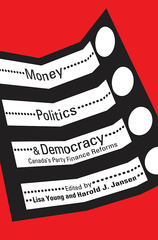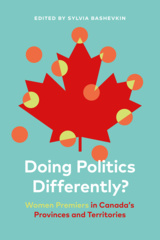
Quebec women have had the right to vote and run for office inprovincial and federal forums for at least six decades, yet they occupya minority of seats in Quebec’s National Assembly and inCanada’s House of Commons and Senate. In 2005, women representedjust under one third of the members of the National Assembly and justover a quarter of Quebec’s delegation in Ottawa.
To explain this situation, Quebec Women and LegislativeRepresentation examines Quebec women’s political engagementsfrom 1791 to the present. It traces the path that led to womenachieving the right to vote and run for office and then explores whywomen, who represent a slight majority of Quebec’s population,always form a minority in its parliamentary spaces. Although a numberof factors are responsible for this deficit, statistics and interviewswith women senators and members of Parliament identify two of seriousconcern – political parties and the voting system.
This innovative account not only documents the significantdemocratic deficit in Canada’s parliamentary systems, it alsooutlines strategies to improve women’s access to legislativerepresentation. It will be of interest to students and scholars ofgender and politics and activists and policy makers who want to enhancewomen’s presence in politics.
This book will be of interest to students and scholars of gender andpolitics and activists and policy makers who want to enhancewomen’s political representation.
Quebec Women and Legislative Representation fills a long-standing gap in the Canadian literature, which is full of acknowledgements that the Quebec context is different but short on attempts to unpack why. On this front, Tremblay's treatment of the topic is compelling ... This book will appeal to large segments of the discipline: specialists of domestic politics; graduate students who should see this book on their comprehensive exam lists, and women and politics scholars ... Its first sentence calls women's under-representation 'a problem' rather than a 'question.' Readers who do no approach this book with the same view will no doubt change their positions by its conclusion.
Quebec Women and Legislative Representation fills a long-standing gap in the Canadian literature, which is full of acknowledgements that the Quebec context is different but short on attempts to unpack why. On this front, Tremblay's treatment of the topic is compelling.... This book will appeal to large segments of the discipline: specialists of domestic politics; graduate students who should see this book on their comprehensive exam lists, and women and politics scholars.... Its first sentence calls women's under-representation 'a problem' rather than a 'question' (1). Readers who do no approach this book with the same view will no doubt change their positions by its conclusion.
Quebec Women and Legislative Representation fills a crucial gap in the Canadian and international literatures in English on women and politics. It presents the welcome voice of a well-informed Quebec scholar, who sheds invaluable light on women’s political history and contemporary participation in la belle province.
Manon Tremblay is a professor of political scienceat the University of Ottawa. Widely published on issues of Canadian andQuebec politics and women and politics, she is editor, most recently,of Women and Legislative Representation: Electoral Systems,Political Parties, and Sex Quotas. Käthe Roth hasbeen a literary translator, working mainly in historical non-fiction,for more than twenty years. She lives and works in Saint-Lazare,Quebec.
List of Illustrations
Foreword / Sylvia Bashevkin
Preface and Acknowledgments
Introduction
1 The Rights to Vote and to Eligibility: Full Access to Citizenship forQuebec Women?
2 Why Does Women’s Representation in the Legislative Spaces ofQuebec Not Match Their Demographic Weight?
3 Quebec Women in Legislatures: What Identity and What Ideas?
4 Increasing the Numbers of Women in Quebec's LegislativeSpaces?
Conclusion
Appendices
Notes
References
Index










